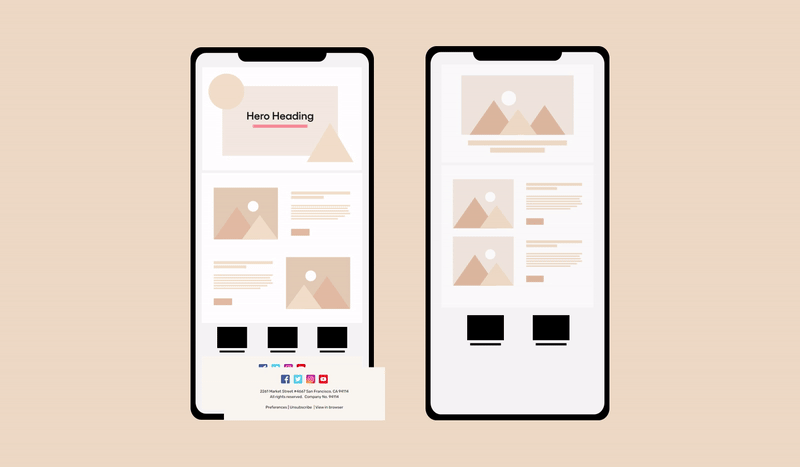The answer to this question might seem obvious, but you’d be pleasantly surprised.
As email marketers, you’re interested in conversions. You reread and retype the email message, so it creates the biggest impact. But how you design the overall email eventually decides how successful it will be. Should you simply write the message or convey it through interesting pictures, strategic calls to action, and vibrant colors?
In this article, we put an end to the decades-old debate of HTML vs. plain text emails.
HTML Vs. Plain Text Emails: The Rundown
How do you differentiate between the two email types? Is there a third email type that email marketers majorly use? Get all the answers below.

Plain Text Emails
As the name suggests, plain text emails include text in its rawest form. No formatting, no embedded links, and no images - just good ol’ text.
Don’t be quick to disregard the idea of sending plain text emails. These emails guarantee maximum deliverability and imitate the likes of having a one-on-one conversation with your customers. Below is an example of how a plain text email looks like;

HTML Emails
HTML, short for HyperText Markup Language, is how you code a document, but we won’t get into the technical details. Simply put, HTML emails include text formatting, visual content, attractive call to action buttons, and whatnot. It’s anything but plain.
HTML emails are great for standing out from the inbox clutter and grabbing your audience’s attention. As per a study, around 67% of people favor reading those emails that mainly feature images. The following image is an example of an HTML email.

Hybrid Emails
Like things are not black and white, most marketers, 62% to be exact, send emails that are a mixture of plain text and HTML. Thus, forming hybrid emails. They are in nature HTML but take on the form of plain text emails with minimal formatting.
Hybrid emails maintain the charm of a one-to-one discussion but with a better overall structure. Refer to the following example of a hybrid email:

For the sake of simplicity, we’ll be considering plain text emails and hybrid emails as one.
Key Differences Between HTML and Plain Text Emails
Since now you’re familiar with the different email types, let’s get into the depth of how they compete against certain factors.
1. Attraction
What looks more attractive; a text-only email or one that features vibrant imagery, a fun GIF, and a striking CTA button?
People, on average, receive 121 emails in a day. When all emails look completely plain, you can find yourself being lost in the inbox clutter. HTML emails grab your audience’s attention, promote positive word-of-mouth, and increase anticipation for future emails.
🏆 Winner: HTML Emails
2. Design
You might think plain text emails will be the winner when it comes to ease of design, but HTML emails are a strong contender. With the widespread popularity of HTML email templates, you can create well-designed emails without needing any coding or design skills. By bringing a few tweaks, you can design personalized HTML emails. The cherry on top? Most HTML email templates can be used free of cost.
🏆 Winner: Both
3. Analytics
There is no point in sending emails if you can’t monitor their results. With anything marketing, it’s a study of analytics that proves the effectiveness of the strategy adopted. You can’t measure the open rate of a plain text email since you need an embedded HTML snippet for that.
🏆 Winner: HTML Emails
4. Email Display
Plain text emails are supported by all email clients. Hence, you can be certain that your email will display as intended when designed.
You can never be sure that the email provider your audience uses supports HTML emails. Just to give you an idea, there are more than 450 email providers, and they all load emails differently. But don’t fret so soon. Many email providers give a fallback option whereby if an HTML email doesn’t load, a plain text email (that you wrote earlier) is sent to your audience.
🏆 Winner: Plain Text Emails
5. Spam
Imagine putting in all this effort only to find emails getting delivered to your audience’s spam folder. Frustrating, right?

Plain text emails can be flagged as spam if the message is too promotional or essential information is absent, like postal address or unsubscribe link. HTML emails may find a spot in the much-dreaded folder if too many images are included.
Whether an email lands in the spam folder depends more upon compliance with anti-spam laws than with if an email is a plain text or HTML.
🏆 Winner: None
6. Readability
Go back to the time when you were in college. When cramming for an exam, did you read a 500-word reference document or watch a 5 minute Youtube video covering the same?
This logic applies here as well. Your plain text emails might be more thorough, but not everyone will bother reading the complete text. In comparison, an email that replaces words with images and videos is easy on the eyes, which results in your audience not only reading but understanding the message as well.
🏆 Winner: HTML Emails
7. Performance
So which email type performs better? Well, studies offer conflicting results.
As per one research, open rates declined by 37% when a GIF was added in a plain text email. However, another study concluded that HTML emails feature a higher click-through rate of 60.67% than its counterpart.
🏆 Winner? Read the Section Below!
Refer to the following table for a quick overview of how plain text and HTML emails stand against the factors discussed.

HTML Vs. Plain Text Emails; Which is Better?
Well, it depends. Whether HTML or plain text emails perform better varies on your audience, industry, and email type.

Audience
HTML emails work well for both B2C and B2B markets. These emails instantly grab your audience’s attention, display your content well, and result in desired clicks. However, plain text emails are suitable for B2B markets only, especially for products that are highly specialized and fall in a niche.
Industry
Companies operating in the IT security and financial services industries should send plain text/hybrid emails because the advanced security rules might flag HTML ones.
For brands operating in the photography, tourism, beauty, and apparel industry, HTML emails should be used. Basically, any industry that requires you to showcase pictures of your products/services requires an HTML email as prospects base their decisions over pictures as opposed to text.
Email Types
For product promotions, newsletters, and event invitations, send emails in HTML format. On the other hand, for transactional emails, surveys, and thank you emails, opt for plain text/hybrid emails.
Important Consideration
While the above takeaways provide a great starting point, it is always suggested to test which email type works best for your brand and targeted audience.

Consider sending the same email copy in both formats, measure which one performs better, and then stick to it.
Conclusion
So HTML vs. plain text emails; which to choose? It depends on your audience, industry, and the type of email you want to send. Consider following the email type suggested for your brand and testing it yourself to create beautiful-looking emails that convert.





